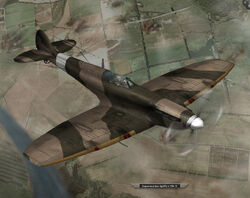| Spitfire MK-V | |
|---|---|
 | |
| Information | |
| Power | Allied |
| Country | Britain |
| Type | Fighter |
| Level | 20 |
| Precursor | Supermarine Spitfire Mark II |
| Successor | Supermarine Spitfire Mark VII |
| Peers | Hawker Hurricane Mark IIB |
| Vital statistics | |
| Speed | 6 |
| Agility | 8 |
| Attack | 4 |
| Defense | 3 |
| Eng Temp | 4 |
| Accelerate | 6 |
| Decelerate | 6 |
| Machine Guns | 4 |
| Cannons | 2 |
| Weapons | 4 |
| Bombs | 2 |
| Features | |
| Low Altitude | Agility +5% |
| Medium Altitude | Agility +5% |
| High Altitude | Speed +5%, Agility +5% |
The Supermarine Spitfire
The Supermarine Spitfire is a British single-seat fighter aircraft that was used by the Royal Air Force and many other Allied countries during and after the Second World War. The Spitfire was built in many variants, using several wing configurations, and was produced in greater numbers than any other British aircraft. It was also the only British fighter to be in continuous production throughout the war. The Spitfire continues to be a popular aircraft, with approximately 53 Spitfires being airworthy, while many more are static exhibits in aviation museums all over the world.
The Spitfire was designed as a short-range, high-performance interceptor aircraft.
During the Battle of Britain (July–October 1940), the Spitfire was perceived by the public to be the RAF fighter, though the more numerous Hawker Hurricane shouldered a greater proportion of the burden against the Luftwaffe. However, because of its higher performance, Spitfire units had a lower attrition rate and a higher victory-to-loss ratio than those flying Hurricanes.
The Mark V
The Mk V was produced in greater numbers than any other single mark of Spitfire. It was the main version of the fighter during 1941, replacing the Mk I and II in service in time to take part in the first British counterattacks over France. During the summer of 1941 it held an advantage over the Bf 109, but in September 1941 the Fw 190 made its operation debut, and the Mk V found itself outclassed. Despite this, it remained the main RAF fighter until the summer of 1942, and the low level LF.Mk V remained in use into 1944.
The Mk V had been designed as an interim mark. The Mk III saw a redesign of the basic fuselage, to carry the more powerful Merlin XX engine. However, that engine was in short supply, and the internal changes in the Mk III would have delayed production. Rolls-Royce had continued work on the Merlin, producing the Merlin 45. This engine produced 1,515 hp at 11,000 feet. It could easily fit in a Mk I or II fuselage, allowing aircraft already under production to be converted to the new standard. Later in the run the similar Merlin 46, 50 and 50A engines were also used in the Mk V. However, while the Merlin XX had a two speed supercharger (one for low altitude and one of high altitude), the Merlin 45 only had the high altitude supercharger.
The first Mk V was produced in January 1941, and tests proved it to be very nearly as good as the Mk III, but without the extra complexity involved in that version. In March 1941 it was decided to produce the Mk V instead of the Mk III. The type had already entered production by this stage, with No. 92 squadron being the first to receive it in February 1941.